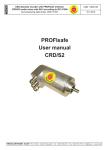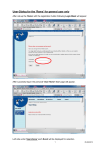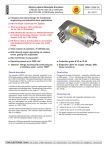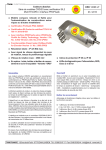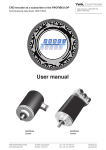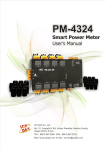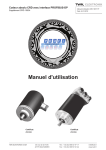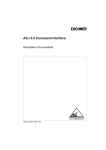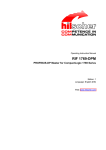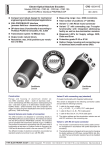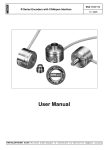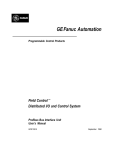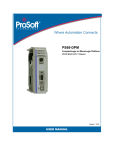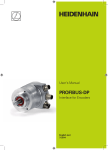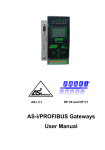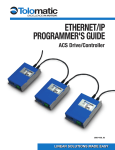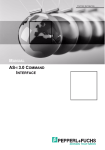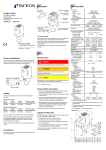Download CRD absolute encoder with PROFIsafe interface CRD/S2 model
Transcript
CRD absolute encoder with PROFIsafe interface CRD/S2 model series with SIL2 according to IEC 61508 Accompanying data sheet: CRD 12098 CRD 12099 GE 03 / 2012 PROFIsafe User manual CRD/S3 TWK-ELEKTRONIK GmbH · PB. 10 50 63 · D-40041 Düsseldorf · Tel.: +49/211/63 20 67 · Fax: +49/211/63 77 05 · [email protected] · www.twk.de COPYRIGHT: The Operating Instructions CRD 12099 is owned by TWK-ELEKTRONIK GMBH and is protected by copyright laws and international treaty provisions. © 2012 by TWK-ELEKTRONIK GmbH POB 10 50 63 40041 Düsseldorf Germany Tel. +49/211/96117-0 Fax +49/211/96117-99 [email protected] www.twk.de CRD 12099 GE / Page 2 Table of contents Inhaltsverzeichnis 1. Safety instructions.............................................................................................................. 6 1.1 Scope of validity............................................................................................................................6 1.2 Documentation..............................................................................................................................6 1.3 Proper use....................................................................................................................................6 1.4 Commissioning.............................................................................................................................6 2. General information on the CRD/S3.................................................................................. 7 3. Specifications for meeting the safety standard............................................................... 8 4. Installation instructions for PROFIsafe............................................................................. 9 4.1 Fundamental characteristics of the transmission technology (RS 485)........................................9 4.2 Wiring and bus termination for PROFIBUS-DP (note: 9-pin sub-D connector).............................9 4.3 Installation of the absolute encoder with connecting cap...........................................................10 5. Monitoring functions for safety-relevant use..................................................................11 5.1 Error type overview table............................................................................................................ 11 5.2 Description of error types............................................................................................................12 5.2.1 Position................................................................................................................................................. 12 5.2.2 Speed................................................................................................................................................... 12 5.2.3 MSA...................................................................................................................................................... 12 5.2.4 Parameters........................................................................................................................................... 13 5.2.5 F parameters........................................................................................................................................ 13 5.2.6 Configuration........................................................................................................................................ 14 5.2.7 Preset................................................................................................................................................... 14 5.2.8 Internal error......................................................................................................................................... 14 6. Data exchange function (DDLM_Data_Exchange)......................................................... 15 6.1 Data format of I/O data...............................................................................................................15 6.2 Positions data.............................................................................................................................15 6.3 Speed.........................................................................................................................................15 6.4 Set reference value (preset).......................................................................................................16 7. Configuration (DDLM_Chk_Cfg)...................................................................................... 17 CRD 12099 GE / Page 3 Inhaltsverzeichnis 8. Parameterisation (DDLM_Set_Prm)................................................................................. 18 8.1 Standard parameters..................................................................................................................18 8.1.1 Bus-specific parameters....................................................................................................................... 18 8.1.2 DP-V1 parameters................................................................................................................................ 18 8.1.3 Encoder specific parameters................................................................................................................ 18 8.1.3.1 Overview......................................................................................................................................... 18 8.1.3.2 Description of encoder parameters................................................................................................. 19 8.2 F parameters..............................................................................................................................20 8.2.1 Overview.............................................................................................................................................. 20 8.2.2 Description of the F parameters........................................................................................................... 20 9. Diagnostic messages (DDLM_Slave_Diag)..................................................................... 22 9.1 Diagnostic overview....................................................................................................................22 9.2 Diagnostic description.................................................................................................................23 9.2.1 Standard diagnostic information (Octet 1-6)......................................................................................... 23 9.2.2 Extended header byte (Octet 7)........................................................................................................... 23 9.2.3 Alarm or status type (Octet 8)............................................................................................................... 23 9.2.4 Slot number (Octet 9)........................................................................................................................... 23 9.2.5 Status specifier (Octet 10).................................................................................................................... 23 9.2.6 Alarm messages (Octet 11).................................................................................................................. 23 9.2.7 Operating status (Octet 12).................................................................................................................. 23 9.2.8 Encoder Typ (Octet 13)....................................................................................................................... 23 9.2.9 Resolution (Octet 14-17)...................................................................................................................... 23 9.2.10 Measuring range (Octet 18,19).......................................................................................................... 23 9.2.11 Additional alarm messages (Octet 20) ............................................................................................... 24 9.2.12 Supported alarm messages (Octet 21,22)......................................................................................... 24 9.2.13 Warning messages (Octet 23,24)...................................................................................................... 24 9.2.14 Supported warnings (Octet 25,26)..................................................................................................... 24 9.2.15 Profile version (Octet 27,28)............................................................................................................... 24 9.2.16 Software version (Octet 29,30)........................................................................................................... 24 9.2.17 Operating time (Octet 31-34).............................................................................................................. 24 9.2.18 Offset value (Octet 35-38).................................................................................................................. 24 CRD 12099 GE / Page 4 9.2.19 Manufacturer offset value (Octet 39-42)............................................................................................. 24 9.2.20 Resolution (Octet 43-46).................................................................................................................... 25 9.2.21 Total measuring steps (Octet 47-50).................................................................................................. 25 9.2.22 Serial number (Octet 51-60)............................................................................................................... 25 9.2.23 Octet 61,62......................................................................................................................................... 25 9.2.24 Manufacturer-specific diagnosis (Octet 63-66)................................................................................... 25 10. Simatic Step7 with Distributed Safety........................................................................... 26 10.1 Integration of the TWK profibus absolute encoder...................................................................26 10.1.1 Installation of the GSD file.................................................................................................................. 26 10.1.2 Selection of the TWK absolute encoder from the Step7 hardware catalogue.................................... 27 10.1.3 Setting of the profibus address........................................................................................................... 27 10.1.4 Install modul....................................................................................................................................... 28 10.1.5 Setting the I/O addresses (S7 addresses)......................................................................................... 29 10.1.6 Parameterisation of the absolute encoder.......................................................................................... 29 10.1.7 Setting the F paramters...................................................................................................................... 30 10.1.8 Setting the diagnostic address........................................................................................................... 30 10.2 General notes regarding the PROFIsafe program....................................................................31 10.2.1 F-Peripherie-DB................................................................................................................................. 31 10.2.2 Processing the F sequence module................................................................................................... 31 10.2.3 PROFIsafe OB 35.............................................................................................................................. 32 10.2.4 Accessing the encoder in the F program............................................................................................ 32 10.3 Example programme................................................................................................................33 11. Scope of delivery............................................................................................................. 37 12. Literature.......................................................................................................................... 37 Appendix A: Absoute encoder terms.................................................................................. 37 CRD 12099 GE / Page 5 1. Safety instructions 1. Safety instructions 1.1 Scope of validity This user manual applies exclusively to the following rotary encoders with PROFIsafe interface: - CRDxx-xxxxRxxxxS3Zxx 1.2 Documentation The following documents must be noted: - The owner's system-specific operating instructions - This user manual - Data sheet number CRD 12098 - The pin assignment enclosed with the device - Installation instruction TZY 10206 enclosed with the device 1.3 Proper use TWK-ELEKTRONIK GmbH's rotary encoders and linear transducers are used to record rotary and linear positions, and make their measured values available as an electric output signal. As part of a system, they must be connected to the downstream electronics and must only be used for this purpose. 1.4 Commissioning •The relevant device must only be set up and operated using this document and the documentation specified in point 1.2. •Protect the device against mechanical damage during installation and operation. •The device must only be commissioned and set up by a specialist electrician. •Do not operate the device outside of the limit values which are specified in the data sheet. •Check all electrical connections before commissioning the system. CRD 12099 GE / Page 6 2. General information on the CRD/S3 2. General information on the CRD/S3 Due to the general spread of the PROFIBUS DP /4/ field bus, only the PROFIsafe-specific extensions are dealt with in this manual. Fundamental and more extensive information on the PROFIBUS DP field bus and PROFIsafe can be obtained from the PNO user organisation (www.profibus.com). The CRD/S3 PROFIsafe absolute encoders are designed for direct connection to the PROFIsafe as slave subscribers in accordance with the PROFIsafe Profile for Safety Technology according to No. 3.092 or 3.192 (PNO) /1/. The encoder protocol is structured in accordance with the PROFIBUS Profile for Encoders according to No. 3.062 (PNO) /2/. PROFIBUS-DP according to IEC61158-3 is used as the data transmission medium. Communication is equipped with a ProfiSafe interface developed by Siemens. Prerequisites for operating on a SIMATIC S7: - Distributed safety at least version 5.4 - F System at least Version 6.1 The parameter data for the absolute encoder with PROFIsafe are described in a GSD file. This GSD file has been created separately and can only be applied for CRD/S3. The CRD/S3 absolute encoder is a sensor for measuring the angular position of a rotating shaft and for determining the number of revolutions which have been carried out. Measurement of the angular speed also takes place. The sensor scans a coding disk with the aid of a special opto chip as the dimensional embodiment of the angular position. Ascertainment of the number of revolutions which have been carried out is implemented via an electrically scanned, mechanical transmission. The measured speed value is determined via the cyclically read-in position data. The dimension is digits per gating time. The speed measurement resolution is independent of the single turn resolution. The following parameters can be programmed: Code sense: Scaling: Resolution: Total measuring steps: Gating time: CW/CCW Encoder programming via the bus can be activated or deactivated using a flag (scaling). 2 to 4096 (8192) steps per revolution 2 to 16,777,216 (33,554,432) steps Time intervall for the counting of steps for the speed measurement. The following monitoring functions are implemented for safety-relevant use: 1.Monitoring of the controller function (memory test and CRC parameter test) 2.Programme sequence monitoring (implementation of inverse functions for the safety-critical programme func- tions). 3.Monitoring of the single turn position via movement detection in which impulses are generated from the position changes. 4.Monitoring of the revolution counter via parallel counting of the single turn zero transitions and comparison with multi-turn scanning. 5.Clock pulse and timer monitoring via a redundant clock pulse generator. 6. Functional monitoring of the FPGAs used to determine the position via a toggle bit which is triggered in the event of controller access. 7.Overvoltage and undervoltage monitoring. 8.Current monitoring for the position-determining light emitting diodes. 9.Supply current overcurrent protection. In deviation from profile definition PNO 3.062, the encoder with Profisafe only has class 2 functionality. The definitions of the error statuses, which are displayed in the „Manufacturer-specific diagnosis“ diagnostic object, Octet 60-63, also deviate from the above mentioned profile CRD 12099 GE / Page 7 3. General information on the CRD/S3 3. Specifications for meeting the safety standard 1. Observance of data sheet CRD12098 and the CRD12099 manual. 2. Maximum permissible rotational speed for applications with SIL2 classification 2500 rpm. 3. Use of an evaluation unit which supports the Profisafe protocol. 4. Evaluation of the F status and the encoder-specific diagnostic data. 5. Connection of a profibus cable in compliance with the standards /3/,/8/. CRD 12099 GE / Page 8 4. Installation instructions for PROFIsafe 4. Installation instructions for PROFIsafe 4.1 Fundamental characteristics of the transmission technology (RS 485) o Network topology: Linear bus, terminating resistors for bus termination Stub lines are only permissible with baud rates < 1.5 MBit/s o Shielded, twisted pair cable Line: o Number of stations: 32 stations in each segment without repeaters Can be extended to 126 with repeaters. 4.2 Wiring and bus termination for PROFIBUS-DP (note: 9-pin sub-D connector) VP (6) Station 1 Station 2 390 RxD/TxD-P (3) Data line B (3) RxD/TxD-P DGND (5) RxD/TxD-P (3) (5) DGND VP (6) 220 (6) VP RxD/TxD-N (8) Data line A (8) RxD/TxD-N RxD/TxD-N (8) Shield/ PE 390 Terminating resistance of the bus Connection DGND (5) Figure 1 Transmission length depending on transmission speed for cable type A Baud rate [kBaud] 9.6 19.2 93.75 187.5 500 1500 12,000 Transmission length [m] 1200 1200 1200 1000 400 200 100 Cable type A specifications: Characteristic impedance: Capacitance per unit length coating: Loop resistance: Core diameter: Core cross-section: 135...165 Ω < 30 pF/m 110 Ω/km 0.64 mm > 0.34 mm² Also see: Installation Guideline for PROFIBUS -FMS/DP (Nr. 2.111/2.112 - PNO) /3/ and Profibus Installation Guideline (Nr. 8.021) /8/ CRD 12099 GE / Page 9 4. Installation instructions for PROFIsafe 4.3 Installation of the absolute encoder with connecting cap The connecting cap for triple connection technology is a T coupler which is installed in the PROFIBUS. The connecting cap must be mounted on the absolute encoder in de-energised condition. There are three cable glands, which are sub-divided as follows: o o o M12x1.5: Voltage supply for the absolute encoder (24 VDC) M16x1.5: Bus in (receive/transmit data A,B) M16x1.5: Bus out (receive/transmit data A‘,B‘) The absolute encoder is connected via the 15-pin SUB-D connector. In the event of an error, the encoder can be replaced without time-consuming installation. The connecting cap is disconnected from the absolute encoder by unscrewing 2 fastening screws. (Note: O-ring seal) The station/subscriber address is set via the DIP switches in the connecting cap. The address range lies between 1 and 126 (default address: 123). Attention! The profibus address in the connecting cap must correspond to the F parameter „F_Dest_Add“ (see Chapter 8.2). The terminating resistors are set via the 10-fold DIP switch (9,10) in the connecting cap; if necessary, these can be activated as line termination. Sub D connector 15 pin socket Connection terminal 1 (± VS) LED status displays Connection terminal 2 (Profibus) B A B´ A´ Plastic u-silices DIP-switches 2 DIP-switches 1 Fastening (captive) EMC-gland M12x1.5 Figure 2 EMC-gland M16x1.5 DIP switches - address setting/terminating resistors Dip-switches 1 2 3 DIP-switches 1 Dip-switches 2 Switch 1 4 5 ON = 1 LSB OFF = 0 Address can be set from 1- 126 (Default address: 123) SRD - data transfer C - class 2 Error message 7 8 1 MSB n.c. 2 Terminating resistors: On ON ON OFF OFF DIP-switches 1 Terminating resistors: ON Off OFF Status LEDs UB - operating supply 6 DIP-switch DIP-switches 2 ON OFF UB SRD C Err Description of error types chapter 5 CRD 12099 GE / Page 10 5. Monitoring functions for safety-relevant use 5. Monitoring functions for safety-relevant use The additionally implemented error types for achieving safety level SIL2 according to IEC 61508 are described in the following. For implementation purposes, extensive modifications have been carried out to the hardware and software in comparison with the basic CRD model absolute encoder with PROFIBUS interface. Error output is carried out via the connecting cap's LEDs, via the profibus diagnostic data (standard and manufacturerspecific diagnosis) (see Chapter 9.2) and via the F status. The bits which are set in the profibus diagnostic data and in the F status are specified in the "Reaction" column. 5.1 Error type overview table Error Position Cause of error Single turn array illumination faulty Impermissible difference between movement detection and position Difference between multi-turn counter (software) and multi-turn scanning Reaction LEDs* UB SRD C Err EXT_Diag Flag = 1 Manufacturer Diag: PositionError F_Status: Device_Fault = 1 FV_activated = 1 on off off on Overvoltage at the supply input Speed Impermissible difference between timer controller and external timer EXT_Diag Flag = 1 Manufacturer Diag: SpeedError F_Status: Device_Fault = 1 FV_activated = 1 on off off on MSA Toggle bit error FPGA EXT_Diag Flag = 1 Manufacturer Diag: MSAError F_Status: Device_Fault = 1 FV_activated = 1 on off off on Parameter Error in parameter message EXT_Diag Flag = 1 Manufacturer Diag: ScalingError Error in the standard parameters Diag.Prm_Fault = 1 Wrong standard parameter CRC-value Diag.Station_Not_Ready = 1 on off on on F parameter F parameter faulty EXT_Diag Flag = 1 Manufacturer Diag: F-Parameter on off/ on off/ on on Configuration Master and slave configurations differ Diag.Cfg_Fault = 1 on on off on Preset Incorrect preset value EXT_Diag Flag = 1 Manufacturer Diag: PresetError F_Status: FV_activated = 1 Internal Incorrect programme sequence Stop controller LED: Flashing code 1 CRC Error ROM Stop controller LED: Flashing code 2 RAM/XRAM Error Stop controller LED: Flashing code 3 Initialization sensor Stop controller LED: Flashing code 4 CRC EEPROM Stop controller LED: Flashing code 5 Error in the sensor, parameter access has failed Stop controller LED: Flashing code 6 Connecting cap expander error Stop controller LED: Flashing code 7 *UB – operating voltage, SRD – data transfer, C - class 2, Err – error message CRD 12099 GE / Page 11 5. Monitoring functions for safety-relevant use 5.2 Description of error types 5.2.1 Position The position and speed data cannot be used. Causes: - Single turn monitoring scanning error - Error in the transmission diode unit - Difference between multi-turn scanning and multi-turn counter - FPGA error - Overvoltage at the supply voltage input - Rotational speed too high Actions: - Device_Fault = 1 - FV_activated = 1 - ExtDiag Flag = 1 - Manufacturer-specific diagnosis = position error (see Octet 63-66) - Light emitting diodes: SRD off UB SRD Class off Error on Remedy: - Reduce the rotational speed to below the maximum value specified in the data sheet. - Check the supply voltage. This must lie within the limits specified in the data sheet. C Err C Err 5.2.2 Speed The position data are OK. Speed measurement is defective. Causes: - Impermissible difference between controller timer and external timer Actions: - Device_Fault = 1 - FV_activated = 1 - ExtDiag Flag = 1 - Manufacturer-specific diagnosis = speed error (see Octet 63-66) - Light emitting diodes: SRD off Class off Erroron UB SRD 5.2.3 MSA The position and speed data are presumably incorrect. The Multi-turn Single turn Array (MSA) is defective. Causes: - Toggle flag does not function correctly Actions: - Device_Fault = 1 - FV_activated = 1 - ExtDiag Flag = 1 - Manufacturer-specific diagnosis = MSA error (see Octet 63-66) - Light emitting diodes: SRD off Class off UB SRD C Error on Err CRD 12099 GE / Page 12 5. Monitoring functions for safety-relevant use 5.2.4 Parameters The encoder does not start up. Causes: - Error in standard parameter parameterisation or wrong standard parameter checksum Actions: - ExtDiag Flag = 1 - Manufacturer-specific diagnosis = scaling error (see Octet 63-66) - Light emitting diodes: SRD off UB SRD Class on Erroron Remedy: - Set permissible values for the standard parameters. C Err C Err 5.2.5 F parameters The encoder achieves data exchange status if no further error is present. Causes: -The transferred F parameters are faulty Actions: - ExtDiag Flag = 1 - Light emitting diodes:: SRD off/on Class off/on Error on UB SRD - Manufacturer-specific diagnosis = F parameter error An error code is set in diagnosis octet 63. The following error codes are possible: Hexadecimal Decimal Error text 0x0040 64 Mismatch of safety destination address (F_Dest_Add) 0x0041 65 Safety destination address not valid (F_Dest_Add) 0x0042 66 Safety source address not valid (F_Source_Add) 0x0043 67 Safety watchdog time value is 0 ms (F_WD_Time) 0x0044 68 Parameter F_SIL exceeds SIL from specific device application 0x0045 69 Parameter F_CRC_Length does not match the generated values 0x0047 71 CRC1-Fault 0x0048 72 Device specific diagnosis information (Wrong F parameter version (F_PAR_VERSION) or wrong CRC length (F_CRC_ LENGTH) Remedy: - Set permissible values for the F parameters. A typical error is an incorrect slave address (F_Dest_Add) CRD 12099 GE / Page 13 5. Monitoring functions for safety-relevant use 5.2.6 Configuration The encoder does not start up. Causes: - Difference between master configuration and slave configuration. Actions: - Light-emitting diodes: SRD on Class off Erroron Remedy: - Transfer a correct configuration message (see Chapter 7) UB SRD C Err 5.2.7 Preset The encoder is fully operable.. Causes: - The preset value lies outside of the set total measuring steps - The scaling flag in the operating mode byte is deactivated. Actions: - ExtDiag Flag = 1 - FV_activated = 1 - Manufacturer-specific diagnosis = preset value error (see Octet 63-66) - Light emitting diodes: unchanged Remedy: - Transfer a pre-set value which lies between 0 and the total measuring steps -1. - Before setting the pre-set value, the "scaling function" bit must be set to "enable". (see chapter 6.4) 5.2.8 Internal error The micro-controller of the encoder stops all actions. A flashing code for the cause of the error is output. Number of flashes (Period approx. 1 s) LED: Flashing code Error cause Flashing code 1 Programme sequence error 1 Flashing code 2 CRC Error ROM 2 Flashing code 3 RAM/XRAM memory error 3 Flashing code 4 Sensor initialisation error 4 Flashing code 5 EEPROM memory error 5 Flashing code 6 Parameter access has failed 6 Flashing code 7 Connecting cap expander error 7 CRD 12099 GE / Page 14 6. Data exchange function (DDLM_Data_Exchange) 6. Data exchange function (DDLM_Data_Exchange) Input data are data which are transmitted from the slave subscribers to the master (actual position value -> master). Reference value control (see below) is listed here as an example of output data; in this case, the master transmits data to the slave (absolute encoder). 6.1 Data format of I/O data Input data: Slave to host Octet 1 Octet 2 MSB Octet 3 Octet 4 Position Data Octet 5 LSB MSB Octet 6 Speed Octet 7 Octet 8 Octet 9 Octet 10 Octet 9 Octet 10 F-Data LSB Definition of F-Data can be found in /1/. Output data: Host to slave Octet 1 Octet 2 MSB* Octet 3 Octet 4 Preset Value Octet 5 LSB MSB Octet 6 Dummy Octet 7 Octet 8 LSB F-Data * Preset control via bit 31: 1/0 6.2 Positions data The position value is output as a 32-bit unsigned integer value in Motorola format (Big-Endian). Octet 1 7 6 5 4 3 Octet 2 2 1 0 7 6 5 4 Octet 3 2 1 0 7 6 5 4 3 Octet 4 1 0 7 6 5 4 3 2 1 0 31 30 29 28 27 26 25 24 23 22 21 20 19 18 17 16 15 14 13 12 11 10 9 8 7 6 5 4 3 2 1 0 0 0 0 0 0 0 0 3 2 25 Bit Position Data CRDxx-8192R4096S3Zxx 0 0 0 0 0 0 0 0 24 Bit Position Data CRDxx-4096R4096S3Zxx 6.3 Speed The speed value is determined via the cyclically read-in of the position data. The dimension is steps per gating time. The gating time (time interval for determining the change of position) is adjustable in the range of 1 - 255 ms. The default value is 10 ms. The speed measurement resolution is independent of the resolution set for the position value (resolution parameter). It is always based on a resolution of 4096 steps per revolution. The steps/gating time unit can be converted to rpm as follows: u= v x 60000 / t v = encoder output for speed value 4096 t = gating time in ms u = speed in rpm The speed value is output as a 16-bit signed integer value in Motorola format (Big-Endian). The following applies to the prefix: positive for increasing position negative for decreasing position Octet 5 7 6 5 4 3 Octet 6 2 1 0 7 6 5 4 3 2 1 0 15 14 13 12 11 10 9 8 7 6 5 4 3 2 1 0 Speed CRD 12099 GE / Page 15 6. Data exchange function (DDLM_Data_Exchange) 6.4 Set reference value (preset) The set reference value function should only be carried out when the absolute encoder shaft is stationary! In order to compare machine position values and the absolute position of the absolute encoder, setting the reference value is unavoidable in certain cases. The reference value is the position value which is displayed in the reference point. The user must note the fact that the reference value must lie within the range 0 to (total measuring steps - 1). In particular, this must be taken into consideration when changing the total measuring steps. The reference value is transferred in data exchange mode by setting bit 7/octet 1. The reference value can only be set when scaling is activated (see Chapter 8.1)! Octet 1 7 6 5 4 3 Octet 2 2 1 0 7 6 5 4 3 2 1 0 31 30 29 28 27 26 25 24 23 22 21 20 19 18 17 16 15 14 13 12 11 10 9 8 7 6 5 4 3 2 1 0 0/1 0 0 0 0 0 0 0 5 4 3 2 1 0 7 6 5 4 3 Octet 4 0 0 0 0 0 0 0 6 Octet 3 1 0/1 7 2 25 Bit Preset Value CRDxx-8192R4096S3Zxx 24 Bit Preset Value CRDxx-4096R4096S3Zxx Preset Control After receiving this message, an offset value (from the current actual position value and the reference value) is calculated by the encoder. If the output actual position value is identical to the reference value, bit 31 can be reset by the master, as preset mode is terminated. The timing diagrams are specified in a separate TY sheet. After bit 31 has been reset, the absolute encoder operates in „normal operating mode“. On inputting a faulty preset value, control bit 31 must be set to zero before inputting the correct preset value in order to rectify the error. After that the preset value can be set again by setting control bit 31 to 1. CRD 12099 GE / Page 16 7. Configuration (DDLM_Chk_Cfg) 7. Configuration (DDLM_Chk_Cfg) Only Class 2 encoders are supported. Class 2 - devices are programmable via the Profibus (set reference value (preset)). The data format is: 10 byte input data and 10 byte output data. The configuration data is: 0xC8,0x89,0x89,0x03, 0x03,0x03,0xA,0x03,0x03,0x03,0x0A. Configuration function (DDLM_Chk_Cfg) Selection Identifier byte Data Class 2 0xC8,0x89,0x89,0x03,0x03,0x03, 10 Byte Input data 0xA,0x03,0x03,0x03,0x0A Data format Encoder position Octet 1/Bit 7: MSB Octet 4/Bit 0: LSB Velocity signal Octet 5/Bit 7: MSB Octet 6/ Bit 0: LSB F-Data Octet 7-Octet 10 10 Byte Output data Preset value Octet 1/Bit 7: Preset Control Octet 1/Bit 0: MSB Octet 4/ Bit 0: LSB Dummy Octet 5/Bit 7: MSB Octet 6/Bit 0: LSB F-Data Octet 7-Octet 10 CRD 12099 GE / Page 17 8. Parameterisation (DDLM_Set_Prm) 8. Parameterisation (DDLM_Set_Prm) The parameterisation data are sub-divided into standard parameters (bus-specific parameters, DP-V1 parameters and manufacturer-specific parameters) and the F parameters. Octet 1-7 Bus-specific parameters Octet 8-10 Standard parameters DP-V1 parameters Octet 11-31 Encoder-specific parameters Octet 0-13 F parameters 8.1 Standard parameters 8.1.1 Bus-specific parameters Octet Data type Description Default 1 BYTE Station status - 2 BYTE WD_Fact_1 - 3 BYTE WD_Fact_2 - 4 BYTE Min. Station Delay Responder (min TSDR) - 5/6 WORD Ident_Number 7 BYTE Group_Ident 0x1962 0 The definition of the bus-specific parameters can be found in /4/ 8.1.2 DP-V1 parameters Octet Data type Description Default 8 BYTE DPV1_Status_1 0x04 9 BYTE DPV1_Status_2 0x00 10 BYTE DPV1_Status_3 0x00 The DP-V1 mode is only supported in that way, that the parameter and diagnosis structure of DP-V1 is fulfilled. The DP-V1 functionality is not supported. 8.1.3 Encoder specific parameters 8.1.3.1 Overview Octet Data type Description Default 11 BYTE Operating mode 12 - 15 LONG Single turn resolution 4096 (8192) 16 - 19 LONG Total measuring steps 16.777.216 (33.554.432) 20 - 27 STRING 28 0x08 Reserved for the profile 0 BYTE Gating time 10 29 BYTE Not used 0 30 - 31 WORD Standard parameter CRC 0x14EC (0x151D) The values in brackets represent the encoders with a total measuring range of 25 bit (CRDxx-8192R4096S3Zxx). CRD 12099 GE / Page 18 8. Parameterisation (DDLM_Set_Prm) 8.1.3.2 Description of encoder parameters Octet No. Bit No 11 0 Parameter Code sequence Range of values Default Description 0: clockwise (cw) 1: counter clockwise (ccw) clockwise (cw) Ascending values on rotation clockwise (cw) or counter-clockwise (ccw). (Viewing direction towards the shaft) 0: disabled 1: enabled enabled Must be set to "enabled" to change the reference value, resolution and total measuring steps. 4096 (8192) 1-2 not used 3 Scaling function status 4-7 not used 12 - 15 Singleturn resolution [steps/turn] 1 - 4096 (8192) 16 - 19 Total measuring steps 1 - 16.777.216 (33.554.432) 20 - 27 Reserved for the profile 28 Gating time [ms] 29 not used 30 - 31 Standard parameter CRC To change, the "scaling function status" parameter must be set to "enabled". 16.777.216 To change, the "scaling function (33.554.432) status" parameter must be set to "enabled". 1 - 255 10 Time interval for the counting of steps for the speed measurement 0 1 - 0xFFFF 0x14EC (0x151D) CRC-checksumme for the standard parameters Remarks: Totals measuring steps: It must be noted that the calculation of the number of revolutions is carried out in 2n powers internally within the encoder. Regardless of this requirement, the user may programme the desired total measuring steps and the desired resolution in accordance with the application. During calculation, the absolute encoder accesses the next highest 2n power if required. In this case, the values are designated as the actual resolution or as the actual total measuring steps, and are displayed as the output value. Example: Desired total measuring steps: Desired resolution: 20,480 4096 Desired number of resolutions: Actual total measuring steps: Actual resolution: Calculated number of revolutions: 5 Internal absolute encoder calculation 32,768 4096 8 (Note:The above mentioned note must be taken into consideration in the event of irreversible operation. In the example which is described, the position 0 is only achieved after 32,767 steps and not, as desired, after 20,479 steps.) Standard parameter CRC: The CRC checksum is build on the following parameters: operating mode, resolution, measuring range and gating time. The calculation is based on the CRC1 algorithm of the Profisafe specification with the polynomial generator 0x14EAB. After changing one of the parameters, the checksum has to be recalculated and entered in the parameter "standard parameter CRC". The checksum calculation program PsCrc.exe is available for download on our homepage www.twk.de. CRD 12099 GE / Page 19 8. Parameterisation (DDLM_Set_Prm) 8.2 F parameters 8.2.1 Overview Overview Octet Data type Description Default 0 BYTE Block-Length 0x0E 1 BYTE Command = 0x05 0x05 2 BYTE Slot 0 3 BYTE Specifier 0 4 BYTE F_Prm_Flag1 14 (für V1 Mode) 5 BYTE F_Prm_Flag2 0 6-7 WORD F_Source_Add 0 8-9 WORD F_Dest_Add 123 10-11 WORD F_WD_Time 2000 12-13 WORD F_Par_CRC (=CRC1) - CRC1: checksum of F parameters CRC2: checksum of processdata CRC3: checksum of Individual parameters 8.2.2 Description of the F parameters Octet 4: F_Prm_Flag1 Bit No. Parameter name Value range Default Remarks 0 F_Check_SeqNr 0: NoCheck NoCheck 1 F_Check_iPar 0: NoCheck NoCheck 2-3 F_SIL 01b: SIL2 SIL2 4-5 F_CRC_Length 00b: 3-Byte-CRC (V2 Mode) 01b: 2-Byte-CRC (V1 Mode) 10b: 4-Byte-CRC (optional V1/V2 Mode 2-Byte-CRC Checksum of the process data (CRC2). Has to be set ot 3 byte CRC in V2 mode. 6-7 not used Value range Default Remarks Octet 5: F_Prm_Flag2 Bit No. Parameter name 0-2 not used 3-5 F_Block_ID No F_iPar_CRC No F_iPar_ CRC 6-7 F_Par_Version 00b: V1-mode 01b: V2-mode 10b: 11b: V1-mode Parameter version CRD 12099 GE / Page 20 8. Parameterisation (DDLM_Set_Prm) Octet 6-13 Octet Parameter name Value range Default Remarks 6-7 F_Source_Add 1 - 65534 8-9 F_Dest_Add 1 - 123 123 Must correspond to the address set in the connecting cap (DIP switches)! 10-11 F_WD_Time 1 - 65534 2000 Monitoring time in the failsafe DP standard slave. Within the monitoring time, a valid, current safety message must be received from the F CPU. 12-13 F_ParCRC (CRC1) 0 - 65535 Automatically assigned by the SIMATIC manager CRC checksum on the F parameters CRD 12099 GE / Page 21 9. Diagnostic messages (DDLM_Slave_Diag) 9. Diagnostic messages (DDLM_Slave_Diag) 9.1 Diagnostic overview Diagnostic messages DDLM_Slave_Diag Diagnostic octet number Diagnostic function Octet Default Remark 1-6 Standard diagnostic information 01 00hex 02 0Chex 03 00hex 04 01hex Parameterisation via master with address 1 05-06 1962hex ID number CRD Response monitoring activate, bit 2 firmly to 1 Device-related diagnosis 7 Extended header byte 3Chex 60 diagnostic bytes 8 Status type 81hex Status block / status message 9 Slot number 00hex 10 Status specifier 00hex 11 Alarm messages 00hex Not supported 12 Operating parameters 08hex CW, scaling on 13 Encoder type 01hex Absolute multiturn encoder 14(MSB)-17(LSB) Resolution 0000.1000hex (0000.2000hex) 4096 (8192) steps/ revolutions 18-19 Measuring range 1000hex 4096 revolutions 20 Additional alarm messages 00hex None 21-22 Supported alarm messages 0000hex None 23-24 Warning messages 0000hex Not supported 25-26 Supported warning messages 0000hex Not supported 27-28 Profile version 0x0101 29-30 Software version xx.xx 31-34 Operating time FFFF.FFFFhex 35-38 Offset value 0000.0000hex Not supported 39-42 Manufacturer offset value 0000.0000hex 43 (MSB) - 46 (LSB) Resolution 0000.1000hex (0000.2000hex) Equal with parameter 47(MSB) - 50 (LSB) Total measuring steps 01.000.000hex (02.000.000hex) Equal with parameter 51-60 Serial number 2A2A2A2A2A 2A2A2A2A2Ahex Not supported 61-62 Reserved 0000hex 63-66 Manufacturer-specific diagnosis 00000000hex Defined during run time The values in brackets represent the encoders with a total measuring range of 25 bit (CRDxx-8192R4096S3Zxx). CRD 12099 GE / Page 22 9. Diagnostic messages (DDLM_Slave_Diag) 9.2 Diagnostic description Explanations regarding the diagnostic information: 9.2.1 Standard diagnostic information (Octet 1-6) For a detailed description, see IEC 61158 Type 3 and IEC 61784, PROFIBUS DP Specification /4/ (Note: Octet 5,6: Manufacturer identification: 1962hex) The manufacturer identification is stored in the PNO and identifies the subscriber as a TWK absolute encoder. 9.2.2 Extended header byte (Octet 7) The length of the extended diagnostic bytes including the header is specified in the diagnostic header (Octet 7). (Profisafe encoder CRD/S3: 3Chex = 60d -> 6 (Standard diagnosis) + 60 (Encoder diagnosis) = 66 Diagnosis bytes) 9.2.3 Alarm or status type (Octet 8) This byte is firmly set to 0x81 and specifies that the diagnostic telegram is a status message. 9.2.4 Slot number (Octet 9) This byte is firmly set to 0x00, because the encoder has no slots. 9.2.5 Status specifier (Octet 10) This byte is firmly set to 0x00, that means there is no further differentiation of the statusmessages. 9.2.6 Alarm messages (Octet 11) No alarm messages are output here. All error messages are output in the manufacturer-specific diagnostic range (octets 63-66) 9.2.7 Operating status (Octet 12) Mirroring of the parameter operating mode. 9.2.8 Encoder Typ (Octet 13) The byte is set firmly to 0x01, i.e. "absolute multiturn encoder" 9.2.9 Resolution (Octet 14-17) Maximum value for the parameter resolution. Parameter Resolution Diagnosis Octet 14 15 16 17 Bit MSB 31-24 23-16 15-8 7-0 LSB 9.2.10 Measuring range (Octet 18,19) The maximum possible number of revolutions, specified via the resolution of the multi-turn section. Depiction in hexadecimal form, e.g. 4096 revolutions = 1000hex. CRD 12099 GE / Page 23 9. Diagnostic messages (DDLM_Slave_Diag) Parameter Measuring range Diagnosis Octet 18 19 Definition MSB 15-8 7-0 LSB 9.2.11 Additional alarm messages (Octet 20) Not currently assigned.. 9.2.12 Supported alarm messages (Octet 21,22) No alarm messages supported. 9.2.13 Warning messages (Octet 23,24) These functions are not supported at present. 9.2.14 Supported warnings (Octet 25,26) These functions are not supported at present. 9.2.15 Profile version (Octet 27,28) Parameter Profile version Diagnosis Octet 27 28 Definition Revision number Index Current encoder profile version: 1.1. 9.2.16 Software version (Octet 29,30) Parameter Software version Diagnosis Octet 29 30 Definition Revision number Index Current software version: 3.04 9.2.17 Operating time (Octet 31-34) This function is not supported at present. The operating time is set to FFFF FFFFhex as default according to the encoder profile. 9.2.18 Offset value (Octet 35-38) The offset value is the value for the shift in the zero point after setting the preset value. Parameter Offset value Diagnosis Octet 35 36 37 38 Bit MSB 31-24 23-16 15-8 7-0 LSB 9.2.19 Manufacturer offset value (Octet 39-42) Not supported at present. CRD 12099 GE / Page 24 9. Diagnostic messages (DDLM_Slave_Diag) 9.2.20 Resolution (Octet 43-46) The resolution set by parametration. Parameter Resolution Diagnosis Octet 43 44 45 46 Bit MSB 31-24 23-16 15-8 7-0 LSB 9.2.21 Total measuring steps (Octet 47-50) Set total measuring steps incremented to the next highest power of two. In this regard, also see the note under chapter 8.1.3.2. Parameter Total measuring steps Diagnosis Octet 47 48 49 50 Bit MSB 31-24 23-16 15-8 7-0 LSB 9.2.22 Serial number (Octet 51-60) This parameter is not supported at present. 9.2.23 Octet 61,62 Reserved 9.2.24 Manufacturer-specific diagnosis (Octet 63-66) Overview Manufacturerspecific Bit diagnosis octet No. Error 63 0-7 F parameter 64 not uses 65 not used 66 0 Scaling 1 Preset value 2 Position 3 Speed 4 MSA 5-7 Not supported A detailed description of the errors can be found in chapter 5 . CRD 12099 GE / Page 25 10. Simatic Step7 with Distributed Safety 10. Simatic Step7 with Distributed Safety This chapter explains the procedure for integrating the TWK absolute encoder into the profibus of a Siemens S7 control system. The documentation is based on Step 7 with distributed safety version 5.4. 10.1 Integration of the TWK profibus absolute encoder Prerequisites: • You have configured your hardware in accordance with the structure of your control system and have installed a profibus sub-network. • You have set the check mark for "CPU contains safety program" in the properties of your CPU and have secured the access to the F-CPU by a password. Figure 3 10.1.1 Installation of the GSD file • • • • Close all projects in the hardware configuration. In the hardware configuration, select Install GSD files under Options. Choose "from the directory", browse to the GSD file CS3_1962.GSD (see figure 4) and click on "Install". If the bitmap is located in the same directory as the GSD-file it is installed automatically, Remark: The GSD-file and the bitmap are available for download on our homepage www.twk.de. Figure 4 CRD 12099 GE / Page 26 10. Simatic Step7 with Distributed Safety 10.1.2 Selection of the TWK absolute encoder from the Step7 hardware catalogue • After opening the hardware catalogue, you will find the encoder CRD/S3 under Profibus-DP, Additional Field Devices, Encoders. • Now open your project, mark the bus and integrate the absolute encoder into the bus by double-clicking onto the corresponding line of the hardware catalogue. Please choose CRD/S3... here. Figure 5 - Afterwars the dialog for setting the Profibus address will appear. 10.1.3 Setting of the profibus address Please specify the address set in the connecting cap via the DIP switches here. In the Subnet field, additionally select your planned profibus and exit the window with OK. Figure 6 CRD 12099 GE / Page 27 10. Simatic Step7 with Distributed Safety 10.1.4 Install modul Than drag the corresponding modul (see article number on the label) on slot 1 of the modul list. Drag to slot 1 of the modulelist Figure 7 The absolute encoder should then appear as follows in your project planning: Double-click to allocate the diagnostic address Double-click to set the I/O addresses for parameterisation Figure 8 The DP ID value results from the configuration, which is firmly set in the case of the Profisafe absolute encoder. The I/O address values are default values, which vary depending on the control system. CRD 12099 GE / Page 28 10. Simatic Step7 with Distributed Safety 10.1.5 Setting the I/O addresses (S7 addresses) Double-clicking onto the „Slot 1“ line opens up the Properties – DP slave window with the Address / ID, Parameter Assignment and PROFIsafe registers. The addresses for the absolute encoder, under which this is to be addressed in the S7, must be assigned under output and input in the Address / ID register. Figure 9 10.1.6 Parameterisation of the absolute encoder Via the Parameter Assignment register, the following window, in which the characteristics of the absolute encoder can be defined, is accessed. (see chapter 8.1.3) Figure 10 CRD 12099 GE / Page 29 10. Simatic Step7 with Distributed Safety 10.1.7 Setting the F paramters Via the PROFIsafe register, the following window, in which the F parameters can be defined, is accessed (see Chapter 8.2) Note: Under certain circumstances, Step7 may show a different default value for F_Dest_Add here. This must be set to the set profibus address! Figure 11 10.1.8 Setting the diagnostic address So that the absolute encoder‘s diagnostic area can be accessed within the S7 programme, it is necessary to assign a specific S7 diagnostic address to it. This may lie within the entire periphery area of the control system. It does not therefore occupy any input/output addresses. The Properties – DP slave window with the General and Parameter Assignment register appears by doubleclicking onto the encoder symbol. On the register General you can now set the diagnostic address and confirm it with OK. No further settings can be done on the register Parameter Assignment. Figure 12 CRD 12099 GE / Page 30 10. Simatic Step7 with Distributed Safety 10.2 General notes regarding the PROFIsafe program Due to the very complex scope for F programme project planning and programming, reference must be made to the documentation from Siemens at this point. SIMATIC S7 Distributed Safety – Project Planning and Programming, Programming and Operating Manual (A5E00109536-03) /6/ and SIMATIC S7 Distributed Safety Getting Started /7/. The sequences required for the PROFIsafe application are listed briefly in the following. 10.2.1 F-Peripherie-DB On translation of the hardware configuration, an F periphery DB is generated for the absolulute encoder, as for each other Profisafe subscriber. The automatically generated name consists of the I/O address and the DP ID. The F periphery DB contains the for the operation of the encoder necessary variables. It has the following appearance: (A detailed description can be found under /6/) Figure 13 10.2.2 Processing the F sequence module To facilitate handling, a safety programme consists of F sequence modules. These consist of: - An F call module F CALL - An F programme module F-PB (this is an F-FB/F-FC, which you assign to the F CALL) - Poss. further F-FBs/F-FCs - One or more F-DBs - F periphery DBs - F library F modules - F system modules (F-SBs) - Automatically generated F modules Figure 14 CRD 12099 GE / Page 31 10. Simatic Step7 with Distributed Safety 10.2.3 PROFIsafe OB 35 The safety programme is acessed by calling F CALL; this takes place directly in an OB, e.g. OB 35. In a wake-up alarm OB, the safety programme is called up and run through at fixed intervals of time. Figure 15 10.2.4 Accessing the encoder in the F program Important for the fail safe operation of the encoder are: reintegration after communication or F periphery errors by the variables „ACK_REQ“ and "ACK_REI", evaluation of the failsafe status by the variable "QBAD" and the evaluation of the diagnostic data by the variable "DIAG". All mentioned variables are provided by the F periphery DB. An example can be found in chapter 10.3. The access to the I/O data of the encoder (position, speed and preset) is only allowed in the safety program (F-FB or F-FC). Because the use of double words in the safety program is prohibited, only word access to the 32 bit position and reference value is possible, that means the position and the reference value are devided into 2 words each and the evalutation has to be done seperately. CRD 12099 GE / Page 32 10. Simatic Step7 with Distributed Safety 10.3 Example program The following example shows how to access the position value and the F periphery DB of the Profisafe absolute encoder in the safety programme. Setting a preset value is also demonstrated. An example for the reading of the encoders diagnostic data can be found in the supplement CRD 12532. The procedure ist the same as under Profibus and is done in the standard program part. Only the programming steps which refer to the TWK absolute encoder are shown here. Knowledge regarding the programming and sequence of the failsafe S7 programme is assumed. As an introduction to failsafe programming, we recommend „SIMATIC S7 Distributed Safety - Getting Started“ /7/ and „SIMATIC S7 Distributed Safety – Project Planning and Programming“ /6/. The OB1 and FB100 modules are available for download on our homepage www.twk.de as archive file „TwkBspSE. zip“. The password for the FB100 is „twk“. Note: TWK-ELEKTRONIK GmbH does not undertake to provide any guarantee for the error-free function of the example programmes shown here! Devices required to operate the example programme - F CPU with profibus interface - Standard input assembly - Standard output assembly - Profisafe CRD absolute encoder - Step7 as of V5.4 + S7 distributed safety as of version V5.4 Hardware structure of the example programme Figure 16 Assigned I/O addresses: Input assembly DI32 Bytes 0...4 Output assembly DO32 Bytes 4...7 Absolute encoder Bytes 100...109 Inputs and outputs used in the programme: E 0.0 E 0.1 EW 100 EW 102 EW 104 A 4.0 A 5.0 A 5.6 A 5.7 AW 100 AW 102 Acknowledgement for reintegration Set preset High word of the encoder position value Low word of the encoder position value Speed value „Acknowledgement required“ display Failsafe status display Display of the threshold value monitoring 1 Display of the threshold value monitoring 2 High word of the encoder preset value Low word of the encoder preset value CRD 12099 GE / Page 33 Programming Access to the profisafe absolute encoder is carried out in an F programme module (here FB100), which must be called up in an F call-up module F CALL. Calling the FB100 in the F CALL is not described here. The preset value and preset bit compilation is contained in a standard module (here OB1). This is carried out here under the prerequisite that setting the preset is not a safety-relevant function.The decision regarding whether setting the preset value is a safety-relevant function must be made depending on the application. The networks 9 and 10 contain examples for a threshold value monitoring. Remark; The position value consists of two words. The compare operation needs integer values. The examples show how to carry out the comparision between the position and the threshold values. The following listing contains only the for the handling of the encoder relevant part. Program blocks like F-CALL, clock OBs or peripheral data blocks are not listed. The non-secure signals in the safety programme (FB100 in this case) are shown in red. CRD 12099 GE / Page 34 10. Simatic Step7 with Distributed Safety OB 1 : Load preset value and interpretation variable DIAG CRD 12099 GE / Page 35 10. Simatic Step7 with Distributed Safety FB 100, NW 1 - 4: Reset, interpretation QBAD and set preset value CRD 12099 GE / Page 36 FB 100, NW 5 - 8: Set preset value and read actual values CRD 12099 GE / Page 37 10. Simatic Step7 with Distributed Safety FB 100, NW 9 - 10: Threshold value monitoring CRD 12099 GE / Page 38 11. Scope of delivery 12. Literature Appendix A: Absolute encoder terms 11. Scope of delivery The scope of delivery includes: - Absolute encoder with PROFIsafe interface - Pin assignment TY XXXXX (depending on the device variant) Available for download on our homepage www.twk.de are: - the corresponding datasheet - this manual - PNO and TÜV certificates - example programs - bitmap and GSD-file - the CRC checksum calculation program 12. Literature /1/ PROFIsafe Profile for Safety Technology, Order No. 3.092, PROFIBUS Nutzerorganisation e. V. Haid-und-Neu-Str. 7, D-76131 Karlsruhe, www.profibus.com PROFIsafe Profile for Safety Technology, Order No. 3.192, PROFIBUS Nutzerorganisation e. V. Haid-und-Neu- Str. 7, D-76131 Karlsruhe, www.profibus.com /2/ PROFIBUS Profile for Encoders, Order No. 3.062, PROFIBUS Nutzerorganisation e. V. Haid-und-Neu-Str. 7, D-76131 Karlsruhe, www.profibus.com /3/ Installation Guideline for PROFIBUS DP/FMS, Order No. 2111/ 2.112, PROFIBUS Nutzerorganisation e. V. Haid- und-Neu-Str. 7, D-76131 Karlsruhe, www.profibus.com /4/ IEC 61158 Type 3 and IEC 61784, PROFIBUS DP Specification /5/ PROFIsafe - Environmental Requirements related to PROFIsafe - Profile for Safety Technology on PROFI BUS DP and PROFINET IO (IEC 61784-3-3), Order No. 2.232, PROFIBUS Nutzerorganisation e. V. Haid-und-Neu-Str. 7, D-76131 Karlsruhe, www.profibus.com /6/ SIMATIC S7 Distributed Safety – Project Planning and Programming, Programming and Operating Manual (A5 E00109536-03) /7/ SIMATIC S7 Distributed Safety Getting Started (A5E00320725-01) /8/ Profibus Installation Guideline, Order No. 8.021, PROFIBUS Nutzerorganisation e. V. Haid-und-Neu-Str. 7, D-76131 Karlsruhe, www.profibus.com Appendix A: Absoute encoder terms Parameter Explanation Resolution – steps/360° The resolution specifies the number of steps per revolution (360°). Measuring range The measuring range specifies the maximum number of revolutions. The revolutions must be specified in 2n powers. Total measuring steps The total measuring steps arise as follows: Total measuring steps = resolution x measuring range Code sequence The code sequence specifies the direction of rotation in which the encoder‘s output code corresponds to ascending values. A distinction is made between the following depending on the direction of rotation: CW - clockwise, clockwise direction of rotation CCW - counter clockwise, anti-clockwise direction of rotation (viewed in the direction of the shaft) Reference value The reference value is the value which appears after the preset function as the encoder‘s actual position value. It lies in the range of values from 0 to total measuring steps -1. CRD 12099 GE / Page 39







































